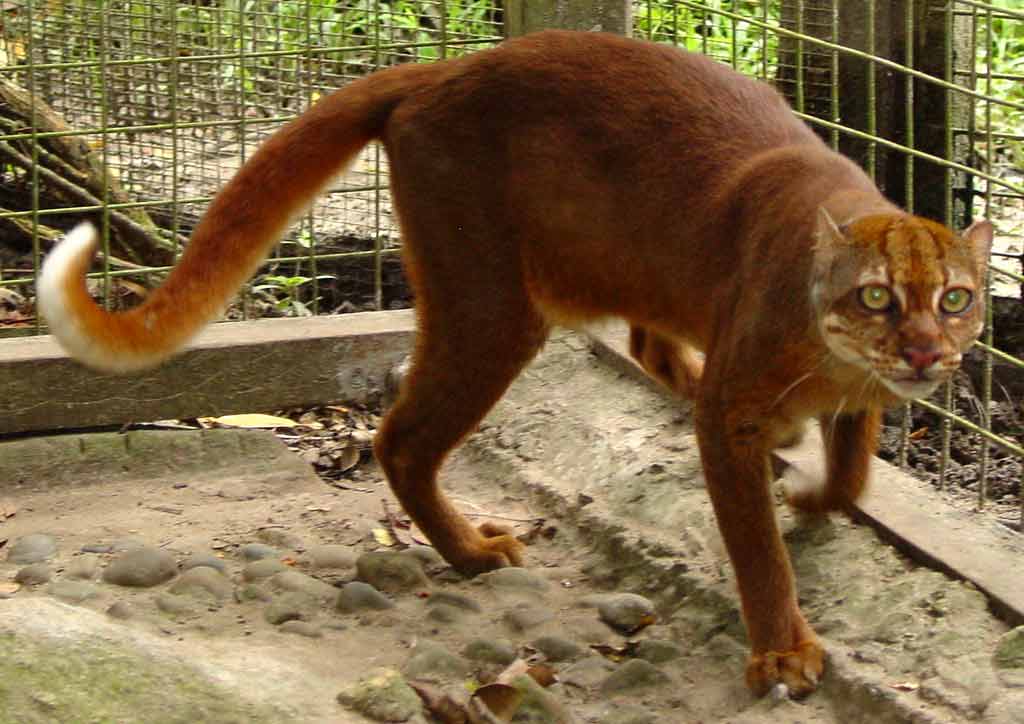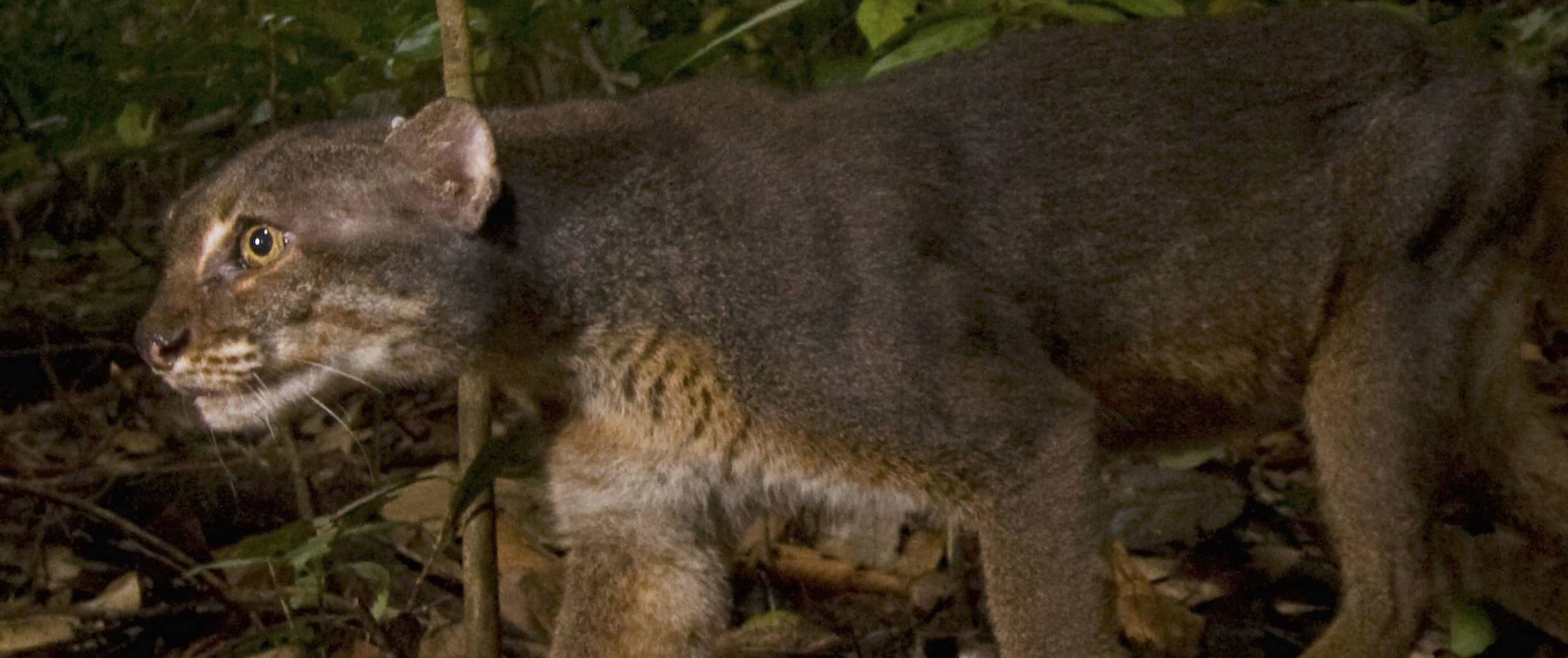The bay cat, scientifically labeled Catopuma badia, epitomizes mystery and allure in the realm of wild felines. Residing predominantly on the lush island of Borneo, this elusive creature goes by various monikers including Bornean Cat, Bornean Red Cat, Bornean Bay Cat, or Bornean Marbled Cat. Unlike its more renowned counterparts, the bay cat boasts an aura of exclusivity and rarity, rendering it a subject of fascination among wildlife enthusiasts and researchers alike.
Its distinctiveness lies not only in its geographical habitat but also in its enigmatic behaviors and physical attributes. From its striking coat to its elusive nature, the bay cat stands as a testament to the wonders of biodiversity and the mysteries that continue to captivate those who seek to unravel the secrets of the natural world.
Borneo Bay Cat: Profile, Traits, Facts, Ecology, Range, Diet
Borneo, a verdant paradise nestled in Southeast Asia, serves as the primary domain of the captivating bay cat. Within the dense jungles and tangled undergrowth of this sprawling island, the cat finds both sanctuary and sustenance. Its existence within this lush ecosystem is a testament to the adaptability and resilience of nature’s creations. Amidst the towering trees and meandering rivers of Borneo, the bay cat maneuvers with stealth and grace, embodying the essence of a true apex predator. Yet, despite its prowess, the cat remains shrouded in mystery, its presence often detected only by fleeting glimpses or the soft rustle of foliage disturbed by its passage.
History of Bay Cats
Naming in 1874: The Bay cats were formally named in 1874, primarily based on the examination of their skull and torn skin. This taxonomical classification provided initial insights into the species, laying the groundwork for further study and understanding.
Introduction to England: Alfred Russel Wallace, the renowned naturalist, played a pivotal role in introducing the Bay cat to England. His exploration and documentation of biodiversity contributed to the broader understanding of wildlife, including the Bay cat.
First Detailed Study in 1992: In 1992, a significant milestone occurred when a Borneo Bay cat was captured, providing naturalists with their first opportunity to conduct a thorough study of the species. This event sparked immense interest and curiosity among researchers, leading to comprehensive examinations and observations.
Unprecedented Insight: The capture of the Bay cat in 1992 offered unprecedented insight into its behavior, habitat, and ecological role. Researchers seized this rare opportunity to delve deeper into the species’ biology and conservation needs.
Advancements in Knowledge: The detailed study of the Bay cat in 1992 marked a significant advancement in our understanding of this elusive feline species. It provided valuable data and observations that continue to inform conservation efforts and scientific research today.
Continued Exploration: Since the landmark capture in 1992, naturalists and researchers have continued to explore and study Bay cats, uncovering new information and expanding our knowledge of this enigmatic species.
Implications for Conservation: The historical context of Bay cat research underscores the importance of ongoing conservation efforts to protect and preserve this unique and vulnerable species. Understanding its history and biology is essential for developing effective conservation strategies aimed at ensuring its survival in the wild.
A Portrait of Uniqueness
Unlike its more recognizable relatives, the bay cat possesses a distinct allure that sets it apart in the realm of wild felines. Its coat, adorned with intricate marbling and hues of russet and ochre, serves as a testament to nature’s artistry. Each pattern, a masterpiece of evolution, aids the cat in blending seamlessly into its verdant surroundings, rendering it virtually invisible to all but the most astute observer. Yet, despite its camouflage, the bay cat remains a symbol of untamed beauty and primal grace, a creature whose very existence evokes a sense of wonder and reverence for the natural world.
The Elusive Nature of the Borneo Bay Cat
Exploring the realm of rare feline species unveils the enigmatic Borneo bay cat, a creature shrouded in mystery and scarcity. Despite its intriguing presence, delving into the depths of its behavior and biology proves to be a formidable challenge for researchers. The cat’s inherent elusiveness renders encounters few and far between, a testament to its mastery of stealth within the dense mountainous terrain it calls home.
A Cloak of Rust-Red Elegance
Standing as a testament to the wonders of nature’s palette, the Borneo bay cat dons a coat of rich, rust-red fur adorned with distinctive white face stripes and a graceful white tail. Each strand of fur serves as a testament to the cat’s unique identity, a tapestry woven with hues that blend seamlessly into the verdant landscape it inhabits. Despite its imposing size, this majestic creature moves with grace and agility befitting of its wild lineage.
Taxonomic Classification of the Borneo Bay Cat
The Borneo bay cat, scientifically classified as Catopuma badia, occupies a distinctive niche within the intricate web of the taxonomic hierarchy. Belonging to the Animalia kingdom, Chordata phylum, Mammalia class, and Carnivora order, this elusive feline embodies the essence of its felid lineage. Within the Felidae family and Felinae subfamily, the Borneo bay cat stands as a testament to the diversity of life within the natural world, with no recognized subspecies further delineating its unique identity.
Unique Traits and Characteristics
In a comparative analysis with its larger cousin, the Asian golden cat, the Borneo bay cat emerges as a diminutive yet captivating counterpart, distinguished by its size and appearance. Adorned in a vibrant chestnut hue, the fur of this majestic creature exhibits subtle variations in coloration, with limbs and tail boasting hues of paler redness in contrast to the body’s rich tones.
Aesthetic Marvels: Tail and Ears
The elegance of the Borneo bay cat extends to its physical features, including a tall, straight tail adorned with a striking white central streak. Its ears, rounded and framed by a brief blackish-brown fur, add to its allure, with a delicate palette of pale brown and slender brown margins further enhancing its aesthetic appeal.
Dimensions and Proportions
Measured from head to tail, the Borneo bay cat spans a range of 49.5 to 67 centimeters, with tails extending from 30.0 to 40.3 centimeters in length. Despite its petite stature, adult individuals typically weigh between 3 to 4 kilograms, a testament to the compact yet formidable nature of this wild feline.
Markings and Facial Features
The short, rounded head of the Borneo bay cat boasts a subtle palette of greyish-brown hues, punctuated by distinctive darkish stripes emanating from the corners of each eye. Notably, the back of the head showcases a unique ‘M’-shaped marking, adding to the cat’s allure and mystique. Beneath the chin, a swath of pristine white fur is adorned with faint brown stripes, while the cheeks bear subtle hints of the cat’s inner grace.
Resemblance to the Jaguarundi
In a curious twist of evolutionary convergence, the body and tail of the Borneo bay cat bear a striking resemblance to the New World jaguarundi, further highlighting the intricate interplay of form and function within the realm of nature’s design. Despite their geographical separation, these two species stand as a testament to the enduring power of adaptation and evolution in shaping the diversity of life on Earth.
Endangered Guardians of the Jungle
In the face of mounting threats and dwindling numbers, conservationists have sounded the alarm for the Borneo bay cat, listing it as endangered. The encroachment of human activity, coupled with habitat loss and fragmentation, has placed these magnificent creatures on the precipice of extinction. With each passing day, the delicate balance of their ecosystem hangs in the balance, a poignant reminder of the fragility of life in the wild.
Kinship in the Wild: Asian Golden Cat Connection
Delving into the genetic tapestry of the Borneo bay cat reveals a fascinating connection to its distant cousin, the Asian Golden Cat. Through both molecular evidence and shared physical traits, the lineage of Catopuma badia emerges as a testament to the intricate web of evolution that binds all living beings. Despite their geographical separation, these two species stand as guardians of the lush jungles they call home, each playing a vital role in maintaining the delicate balance of their shared ecosystem.
Anatomical Marvels: Dentition and Morphology
Beyond its striking appearance, the Borneo bay cat harbors anatomical marvels that set it apart from its feline brethren. The distinct dentition of Catopuma badia, characterized by a smaller-than-normal first upper pre-molar tooth, speaks to the intricate adaptations honed through millennia of evolution. Coupled with its short, rounded head and singular root structure, this wild cat stands as a testament to the wonders of nature’s design, a masterpiece of form and function sculpted by the forces of survival.
A Precarious Existence
Since its designation as Endangered on the IUCN Red List in 2002, the Borneo bay cat has faced an uphill battle for survival. With estimates suggesting a population of no more than 2,500 mature individuals, the precariousness of their existence looms large in the collective consciousness of conservationists. Even within its pristine habitat, the cat’s presence remains a rare and cherished sight, a poignant reminder of the fragility of life in the wild.
More Interesting Articles
- Gilbert’s Potoroo – Profile | Traits | Facts | habitat | Population
- Striped Grass Mouse – Profile | Traits | Facts | Pet | Habitat | Diet
- Desert Rat Kangaroo – Profile | Traits | Facts | Adaptations | Diet
- Musky Rat-Kangaroo – Profile | Traits | Facts | Habitat | Baby
- Northern Brown Bandicoot – Profile | Traits | Facts | Habitat | Diet
- Grey Dwarf Hamster – Profile | Facts | Traits | Cute | Baby | Lifespan
- European Hamster – Profile | Facts | Traits | Size | Pet | Baby
- Campbell’s Dwarf Hamster – Profile | Facts | Traits | Colors | Size
- Winter White Dwarf Hamster – Profile | Facts | Traits | Color | Eyes | Pet
- Mongolian Hamster – Profile | Facts | Traits | Dwarf | Range | Diet
- Turkish Hamster – Profile | Facts | Traits | Habitat | Diet | Pet
- Romanian Hamster – Profile | Facts | Traits | Diet | Range | Baby
- Syrian Hamster – Profile | Facts | Traits | Size | Color | Cute | Poop
- 19 Different Types of Hedgehogs – Profile | Facts | Traits | Pet
- Four-Toed Hedgehog – Profile | Facts | Traits | Size | Cute | Baby
- European Hedgehog – Profile | Facts | Traits | Size | Pet | Habitat
- Woodland Hedgehog – Profile | Facts | Traits | Baby | Diet | Range
- Northern White-Breasted Hedgehog – Profile | Facts | Traits
- Amur Hedgehog – Profile | Facts | Traits | Distribution | Diet
- Indian Hedgehog – Animal | Profile | Facts | Traits | Protein | Habitat

